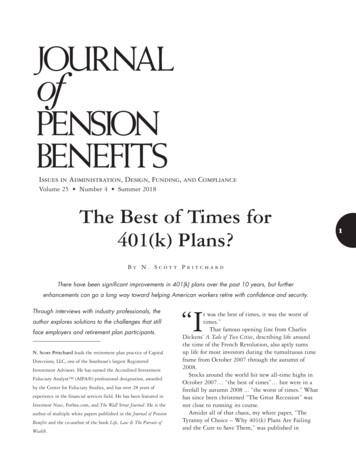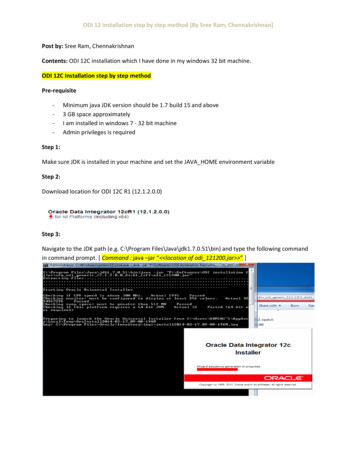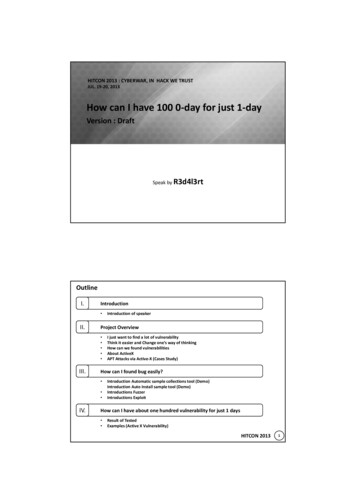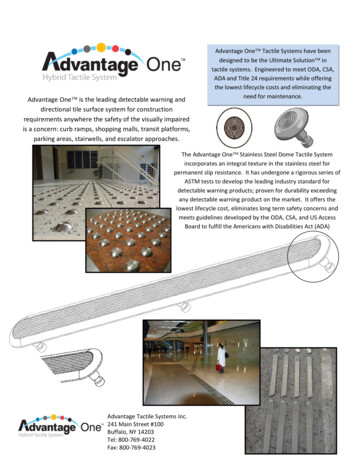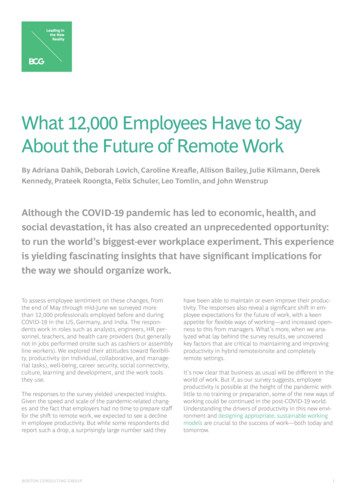
Transcription
What 12,000 Employees Have to SayAbout the Future of Remote WorkBy Adriana Dahik, Deborah Lovich, Caroline Kreafle, Allison Bailey, Julie Kilmann, DerekKennedy, Prateek Roongta, Felix Schuler, Leo Tomlin, and John WenstrupAlthough the COVID-19 pandemic has led to economic, health, andsocial devastation, it has also created an unprecedented opportunity:to run the world’s biggest-ever workplace experiment. This experienceis yielding fascinating insights that have significant implications forthe way we should organize work.To assess employee sentiment on these changes, fromthe end of May through mid-June we surveyed morethan 12,000 professionals employed before and duringCOVID-19 in the US, Germany, and India. The respondents work in roles such as analysts, engineers, HR personnel, teachers, and health care providers (but generallynot in jobs performed onsite such as cashiers or assemblyline workers). We explored their attitudes toward flexibility, productivity (on individual, collaborative, and managerial tasks), well-being, career security, social connectivity,culture, learning and development, and the work toolsthey use.The responses to the survey yielded unexpected insights.Given the speed and scale of the pandemic-related changes and the fact that employers had no time to prepare stafffor the shift to remote work, we expected to see a declinein employee productivity. But while some respondents didreport such a drop, a surprisingly large number said theyBOSTON CONSULTING GROUP have been able to maintain or even improve their productivity. The responses also reveal a significant shift in employee expectations for the future of work, with a keenappetite for flexible ways of working—and increased openness to this from managers. What’s more, when we analyzed what lay behind the survey results, we uncoveredkey factors that are critical to maintaining and improvingproductivity in hybrid remote/onsite and completelyremote settings.It’s now clear that business as usual will be different in theworld of work. But if, as our survey suggests, employeeproductivity is possible at the height of the pandemic withlittle to no training or preparation, some of the new ways ofworking could be continued in the post-COVID-19 world.Understanding the drivers of productivity in this new environment and designing appropriate, sustainable workingmodels are crucial to the success of work—both today andtomorrow.1
The Productivity QuestionTo understand why, we dug more deeply into the data. Andwe focused our analysis on collaborative tasks because, asour survey reveals, in this new remote or hybrid world,collaborative work seems harder and appears to generatethe most concern among employers—many of whomassume teams need to meet in person to collaborate. Wefound four factors that correlate with employee perceptions of their productivity on collaborative tasks, whetherworking remotely or onsite: social connectivity, mentalhealth, physical health, and workplace tools.It’s hard to overestimate the disruption to work that hastaken place over the past several months. Our surveyfound the pandemic has forced employers to move anunprecedented share of employees—some 40%—to remote working. And for those still onsite, social distancingand collaborating remotely with colleagues have transformed the workplace experience. Remarkably, however,instead of finding a collapse in the functioning of business,our research reveals something few might have predicted:employees perceive that their productivity has predominantly stayed the same or even improved.An impressive 79% of respondents who indicated they aresatisfied or doing better on all four of these factors saidthey have been able to maintain or improve productivity oncollaborative tasks. In contrast, employee dissatisfactionwith a high number of these factors is cause for concern.When we looked at respondents who are dissatisfied ordoing worse on at least three factors, only 16% (from asmall sample size, with a confidence interval of /- 3% at80% confidence) said they have been able to maintain orimprove productivity. That’s a difference of almost 400%!While this is a subjective productivity indicator, the data isstill striking. Some 75% of employees said that during thefirst few months of the pandemic they have been able tomaintain or improve productivity on their individual tasks(such as analyzing data, writing presentations, and executing administrative tasks). On collaborative tasks (includingexchanges with coworkers, working in teams, and interacting with clients), the number is lower. But even so, morethan half—51%—of all respondents said they have beenable to maintain or improve their productivity on collaborative tasks. What’s more, this applies across geographicareas as well as to both remote employees and those whohave remained mostly onsite—indicating that changes tothe ways of working are having an impact across the board.(See Exhibit 1.)We now walk through each factor in turn.Social Connectivity. Most surprising in our analysis is theoutsize impact that social connectivity has on productivity:employees who reported satisfaction with social connectivity with their colleagues are two to three times morelikely to have maintained or improved their productivity onExhibit 1 - Many People Have Maintained or Improved Productivity DuringCOVID-19, but Fewer Have Done So on Collaborative TasksIndividual tasks (%)Managerial tasks (%)Collaborative tasks eStayedremoteTransitionedto remoteStayedonsiteStayedremoteTransitionedto remoteStayedonsiteStayedremoteTransitionedto remoteAs productive or more productivethan pre-COVID-19Less productivethan pre-COVID-19Employers need to unlock productivity on collaborative tasks, especially if employees work remotelySource: BCG COVID-19 Employee Sentiment Survey, May 21 to June 13, 2020 (N 12,662 in the US, Germany, and India), unweighted, representativewithin /-3% of census demographics.Note: “Stayed onsite” are respondents who reported working a majority of their time ( 3 days per week) onsite prior to and during the COVID-19pandemic; “stayed remote” worked 3 days per week remotely prior to and during the pandemic; “transitioned to remote” reported switching fromworking 3 days per week onsite prior to the pandemic to working 3 days per week remotely during the pandemic.2 WHAT 12,000 EMPLOYEES HAVE TO SAY ABOUT THE FUTURE OF REMOTE WORK
The survey findings show thatsocial connectivity is what enablesus to be collaboratively productive.
collaborative tasks than those who are dissatisfied with theirconnections. (See Exhibit 2.) Social connectivity, it turns out,is what enables us to be collaboratively productive. Andcollaborative productivity is essential for any company looking to improve communication, increase efficiency, accelerateskills acquisition, or harness innovation.Furthermore, our survey suggests that employees miss theconnectivity they had with colleagues in the office. Respondents told us they miss “being able to spontaneously walkto a coworker’s desk and discuss an issue” and “socialgatherings at work.” It will be critical for companies torecreate this connectivity regardless of where employeesare located.Physical Health. For a long time, physical health hasbeen recognized as a driver of productivity, reducing absenteeism and creating a more focused, higher-performingworkforce. Our findings provide compelling evidence ofthis: employees who have experienced better physicalhealth during the pandemic than before it are about twiceas likely to have maintained or improved their productivityon collaborative tasks as those with worse physical health.This highlights the importance of building time for sleep,exercise, and nutrition into the new work routines.Workplace Tools. When we asked respondents abouttheir satisfaction with tools such as videoconferencing,virtual white boards, and project management software, wefound another powerful driver of productivity: employeeswho are satisfied with their tools are about twice as likelyto have maintained or improved their productivity oncollaborative tasks as those not satisfied with their tools.One tech industry respondent said that “having a desksetup the same as the office and home with the sameconnectivity” is essential for him in maintaining productivity, while other respondents reported that digital applications and tools such as videoconferencing are important tomaintaining their productivity levels.Mental Health. Similarly, survey responses show a correlation between mental health and productivity: peoplewho have experienced better mental health during thepandemic than before it are about two times more likely tomaintain or improve their productivity on collaborativetasks than those who have experienced worse mentalhealth. While awareness of the impact of mental health onwork has been increasing, the pandemic—and the stressesand anxieties it has created—underscores how critical it isfor employers to recognize the links between mentalhealth and productivity.Exhibit 2 - Employees Satisfied with Social Connectivity Are More Likely toMaintain or Improve Productivity on Collaborative TasksUSNot satisfiedwith socialconnectivity20%GermanySatisfiedwith socialconnectivity3.2x63%37%80%Not satisfiedwith socialconnectivity27%IndiaSatisfiedwith socialconnectivity1.9x73%As productive or more productivethan pre-COVID-1950%50%Not satisfiedwith socialconnectivity24%76%Satisfiedwith socialconnectivity2.4x58%42%Less productivethan pre-COVID-19Source: BCG COVID-19 Employee Sentiment Survey, May 21 to June 13, 2020 (N 12,662 in the US, Germany, and India), unweighted, representativewithin /-3% of census demographics.4 WHAT 12,000 EMPLOYEES HAVE TO SAY ABOUT THE FUTURE OF REMOTE WORK
A New World of WorkShifts in the way we work are likely to continue as employers move a growing portion of their employees to moreflexible models. In fact, BCG’s recent Workplace of theFuture employer survey found that companies expectabout 40% of their employees to follow a remote-workingmodel in the future.One financial services company told us it believes a hybridmodel (rather than 100% remote) would likely be theworking model of choice for many of its employees, whosee 100% remote work as unsustainable. The companysaid that its employees worked an estimated 25% of theirtime remotely before the pandemic, and it believes thatthis figure could rise to approximately 50% or more.Employer expectations are in line with the seismic shift inthe way employees are thinking about their workplace. Inour research, 60% of employees said they want some flexibility in where and/or when they work. (See Exhibit 3.) Thisresponse was most pronounced in the US (67%), while thefigure was 50% in India. Combined with our findings onwhat drives employee productivity, this underscores thefact that listening and responding to what employees wantare essential to a company’s success, including its abilityto attract and retain talent.It is encouraging, therefore, that managers appear receptive to flexible models. In our survey, we were struck to findthat of respondents who are managers—and some mightnot expect all managers to welcome increased flexibility—most are in fact very open to this. Over 70% of managerssaid they are more open to flexible models for their teamsthan they were before the pandemic.What This Means for EmployersOur findings suggest that the future of work will be increasingly hybrid. And this presents both challenges and opportunities: to reimagine the entire employee experience andto create conditions that allow employees to thrive in theworkplace of the future—one that will be far less officecentric. This means developing new hybrid working modelsthat enable employees to move seamlessly between onsiteand remote work, as well as thinking about the appropriatephysical space—both size and shape—for the hybrid office.Some challenges are more demanding than others. Thegood news is that companies have already been investingheavily in the tools needed to work remotely. In our Workplace of the Future survey, 87% of employers said theyanticipate prioritizing tech and digital infrastructure investments that support sustained remote work.Exhibit 3 - A Majority of Respondents Want Some Flexibility in Whereand/or When They Get Their Work DoneFuture desire for“where” flexibilitySome flexibilityin where I workSometimes,most of the time,or almost alwaysLess thansometimes8%Some flexibility in bothwhen and where I work40%of respondentsof respondentsLow to no flexibility inwhen and where I workSome flexibilityin when I work39%60% of respondents indicatethey want some flexibilityin where and/or when theywork in the future12%of respondentsof respondentsLess than sometimesSometimes, most of the time,or almost alwaysFuture desire for “when” flexibilityKeyRespondent indicates a desire for where and/or when flexibilitysometimes, most of the time, or almost always (i.e., “some” flexibility)Respondent does not indicate a desire for where and/or when flexibilitysometimes, most of the time, or almost always (i.e., “low to no” flexibility)Source: BCG COVID-19 Employee Sentiment Survey, May 21 to June 13, 2020 (N 12,662 in the US, Germany, and India), unweighted, representativewithin /-3% of census demographics.Note: Numbers do not total 100% because of rounding.BOSTON CONSULTING GROUP 5
The future of work will beincreasingly hybrid—a blend ofonsite and remote locations.
When it comes to promoting good employee health, companies need to focus on both physical health and mentalwell-being. While employees who are no longer commutinghave more time to exercise, it is easy for them to be sedentary when working remotely. Meanwhile, with 29% of respondents telling us they have experienced worse overallmental health during COVID-19, it is imperative for employers to create awareness and develop tools and benefitsthat support employees’ nee
For a long time, physical health has been recognized as a driver of productivity, reducing absen-teeism and creating a more focused, higher-performing workforce. Our findings provide compelling evidence of this: employees who have experienced better physical health during the pandemic than before it are about twice as likely to have maintained or improved their productivity on collaborative .
